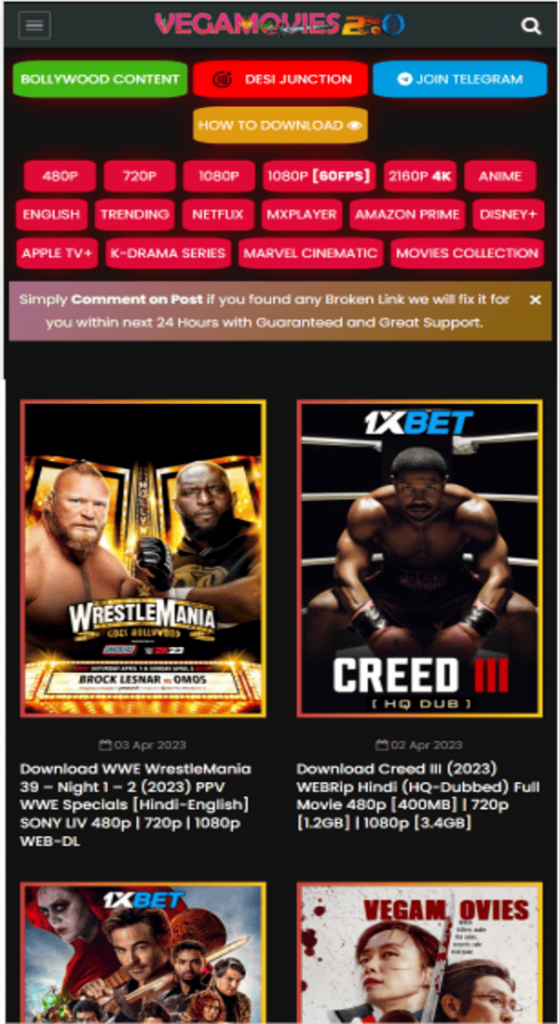Is the digital landscape truly the wild west for cinematic content, or can order be established? The proliferation of platforms like Vegamovies has sparked a complex battleground of copyright, access, and audience demand, fundamentally reshaping how we consume films.
The relentless march of technology has gifted us with unprecedented access to information and entertainment. Yet, this convenience has simultaneously created fertile ground for the unauthorized distribution of copyrighted material. The rise of platforms like Vegamovies, and the buzz surrounding the availability of films such as Dunki, exemplifies this ongoing struggle. The expectation of instant access, the desire to share reviews, and the potential for a vast audience to be reached – these are the elements fueling a constantly evolving media landscape. The case of Dunki showcases the immediate pressure from audiences eager to see the latest releases immediately after their theatrical premieres. This eagerness creates demand, which, in turn, encourages those who provide unauthorized access. The constant cat-and-mouse game between content creators, distributors, and those who seek to provide illegal access is a reflection of how quickly the world of entertainment is changing. It is no longer enough to simply release a film in theaters; now, the success of that release is directly tied to the film's ability to withstand the inevitable tide of online sharing, and the speed with which it spreads across the internet. This has far-reaching implications for the entire industry and affects every movie, from the smallest independent production to the biggest Hollywood blockbuster.
The impact extends beyond simple piracy. Copyright law, once relatively straightforward, is now under immense strain. Courts like the Delhi High Court, in cases like *Star India Pvt Ltd v Vegamovies*, are tasked with navigating these murky waters, striving to balance the rights of content creators with the public’s evolving expectations of access. This legal complexity is further amplified by the global nature of the internet. With platforms operating across borders, enforcement becomes incredibly challenging. The authorities face a constant barrage of new websites, and methods of distribution that are difficult to track and regulate. The legal battles, the takedown requests, and the constant attempts to safeguard intellectual property are all part of a continuous, ongoing struggle. The core issue is not just about lost revenue; it’s about the future of the creative industries, and their ability to thrive in an environment where their work can be easily duplicated and shared without authorization. The conversation around this issue needs to move beyond simple condemnation and begin to address the underlying factors. The industry must find innovative solutions, such as making content more easily accessible through legal channels, while also continuing the fight against piracy.
The rise of such platforms doesn't just impact big studios. Independent filmmakers and smaller production companies, who often operate on tighter budgets, are particularly vulnerable. The loss of revenue through unauthorized distribution can seriously undermine their ability to invest in future projects and contribute to a diverse film ecosystem. Furthermore, the distribution of low-quality, pirated versions of movies can harm the viewing experience, discouraging people from appreciating the work that goes into the creation of these films. The creative process is often a labor of love. When that labor is not protected, the whole system is damaged. The fight is not just about protecting profits; it is about preserving the creative environment for future generations of filmmakers. The evolution of viewing habits has changed the way audiences experience movies. From the traditional theater experience to streaming platforms and video rentals, the entertainment landscape has evolved. This evolution has been fueled by technological advancements and the growing demand for on-demand access.
The constant presence of these platforms is a powerful reminder that the fight against piracy is never truly won. It is a battle that demands a multi-pronged approach. This strategy requires technology, collaboration, legal action, and consumer awareness. This includes employing robust content protection measures, working in partnership with internet service providers to block access, and educating the public about the legal and ethical implications of pirated content. The goal is to foster a culture that values and respects intellectual property and emphasizes the importance of supporting the creators behind the films we enjoy. Consumers need to be educated on the risks of accessing illegal content. These risks extend beyond the legal consequences; they also encompass the danger of malware and viruses that often come bundled with pirated downloads. As the entertainment industry continues to develop, the conversation surrounding piracy will continue to evolve. The goal is to balance the public's demand for convenient access with the legitimate needs of content creators to protect their rights and investments. The industry’s continued success depends on how it adapts to these complex challenges.
The conversation around platforms like Vegamovies and the availability of films like Dunki underscores a fundamental shift in the way we engage with cinema. The desire for instant access, the push for immediate reviews, and the technical means to achieve these ends have created a landscape that is both thrilling and treacherous. While piracy poses significant challenges, it also compels the industry to innovate, to seek new ways to deliver content to audiences, and to reaffirm the value of creativity in the digital age. As digital technology advances, and audience expectations shift, the film industry will have to keep finding ways to ensure their work is protected, while also adapting to a world where access is increasingly immediate. The future will depend on the ability to find the right balance between protection and accessibility.
The case of Shenandoah, referenced in relation to the platform Vegamovies, draws a different angle to the story. The availability of such films on platforms of this nature not only undermines copyright but can potentially offer misleading narratives, especially for historically-based content. If viewers access a version of a movie that is incomplete or tampered with, it's possible that the historical context could be misconstrued, leading to potential distortion.
Platforms like Vegamovies are continually innovating. As the internet matures, so does the way these platforms operate. There will always be a cat-and-mouse game as legal and ethical entities strive to remain one step ahead of those who try to take advantage of the open nature of the internet.


